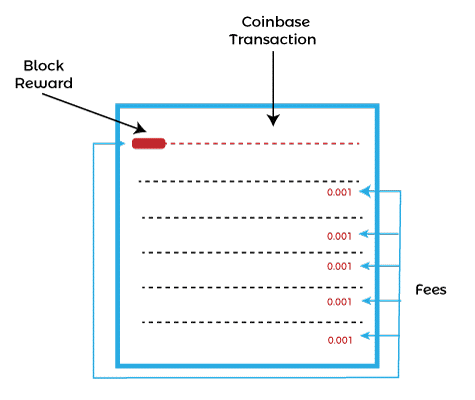Coinbase Transaction
Several transactions occur on a cryptocurrency network, but these transactions may not be transactions between two people. Some transactions which take place are a bit different from other transactions. & Coinbase is a transaction. The block transaction in Bitcoin was the 1st transaction of the Coinbase. Miners create these types of unique Bitcoin transactions. Miners use these to collect their prizes or reward for the work they have done & some other fees charged by miners are sent through this transaction.
Structure of Coinbase Transaction

A Bitcoin transaction is also a type of transaction which shows how the Bitcoin moves from one wallet to another. But in Coinbase transactions, it generates or creates new currencies that have never been spent & that's why input remains empty or blank in these types of transactions. The single blank input in the Coinbase transaction is called The Coinbase.
Raw Data
Let us take the example of a Coinbase transaction. The data we are using here doesn't refer to the original transaction. Coinbase transaction credentials are always visible.
Example
0100000001b0ece12b8657b19b8cce9506dedf62f1c582894528756753b255f717b6768c94ffffffff4503ec59062f48616f3254432f53756e204368756e2059753b205a6875616e67205975616e2c2077696c6c20796f75206d61727279206d653f2f06fcc9cacc19c5f278560300ffffffff0112dRugNbdxK39288NjeDV4GX7rMdKCGn6B00000000.
Characteristics of Coinbase Transaction’s
1. Using Cryptocurrency from Coinbase Transaction
The Blockchain, which is earned from Coinbase transactions, can't be used or spent unless & until 200 confirmations is reached in Blockchain. The rewards gained or earned can't be spent unless & until the transaction receives a certain no. of confirmations in Blockchain. For example, if Bitcoin, the no, is 200.
2. The 1st transaction in a new block
The first transaction in a new block is usually the Coinbase transaction. The rewards generated by transactions are sent to multiple or single wallets; it works like cryptocurrency transactions.
3. Halving
The rewards of Coinbase transactions are determined by value. After adding some blocks successfully to Blockchain, rewards generated after adding a block successfully are reduced by fifty per cent. & this is known as halving. This usually occurs in Bitcoin after 21000 blocks are added and successfully mined. The rewards are decreasing day by day. Initially, it was 50 BTC per block; after that, 25 BTC, and now it's 12.5 BTC.

Transactions executed on the Bitcoin network are grouped to form or create a block. When a block is created, it will be added to Blockchain immediately. These blocks that are added are tamper-proof & immutable for all the transactions done on the Bitcoin network. Each block contains atleast one transaction or usually more than one transaction. & this block which contains transactions is called the coinbase transaction.
Creating the block is the responsibility of the miners. Miners get rewarded (Bitcoin) for their work whenever a new block is added successfully. The Bitcoin block is dependent on the no. of blocks from the genesis block & the fees are included in the transactions of the block. The sum of rewards & fees of transactions from all the transactions that have been in a block is the total no. of rewards that miners get.
Now, the reward is going to be reduced to 6.5 BTC.
Transactions can be only spent if there is a minimum of 100 block confirmations in the Blockchain. & it is an important feature present in the coinbase. So, it can only be spent if at least 100 blocks are confirmed.
Getting the value of the coinbase transactions
- The value of each output and each input of transactions are verified by a certain block included.
- Halving is always related to block.
- In a broader sense, the no. of a transaction in a particular block is considered or the height of that particular block. If the transactions increase, the fees & commission also increase; they are directly proportional to each other.
- Last, the miners' job is to create coinbase transactions that include the total no. of rewards & fees. Halving values are almost equal to the rewards generated.

Some examples from the Bitcoin website show the real coinbase transaction
There are some interesting things about coinbase transactions
1. 1st coinbase transaction
While mining the Bitcoin block in the year 2009, there generated a Bitcoin address and there generated coinbase, which was then sent to that address. But before that itself, the address had 50 BTC but couldn't be spent & the block never got confirmation in the Blockchain.
2. Maturity of coin
A certain no. of confirmations occurs after only a coinbase transaction can be spent.